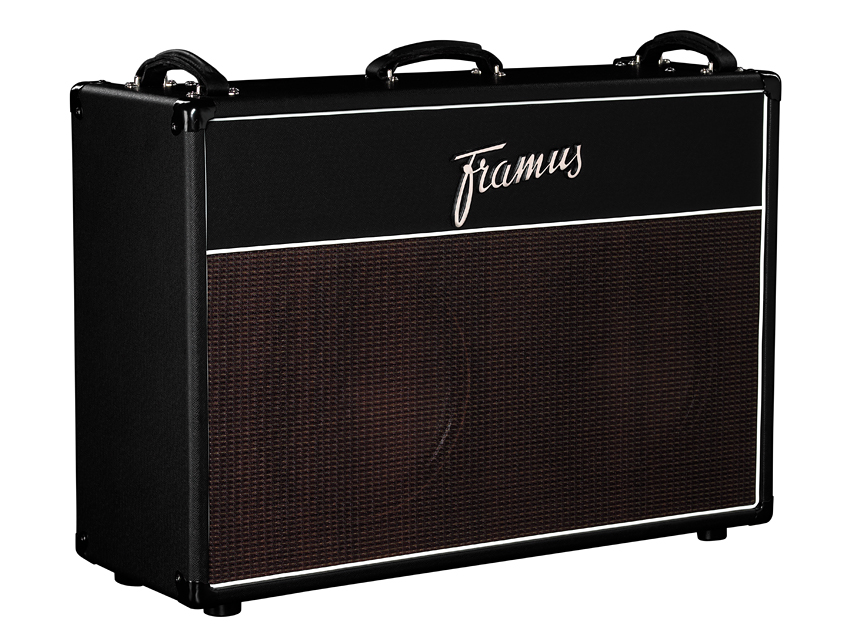MusicRadar Verdict
A pro-level gigging combo with great cleans and varied rock tones.
Pros
- +
Response and feel. Versatile rock tones. Quality construction.
Cons
- -
Hefty (31 kg).
MusicRadar's got your back

Framus Ruby Riot II

Framus Ruby Riot II
The Ruby Riot II is the latest version of Framus's flagship combo. Like its predecessor, this German-made all-valve 2x12 owes a significant debt to that paragon of British amp design, the Vox AC30.
The combination of a quartet of EL84s in a Class A configuration with Celestion speakers, a tremolo circuit and chicken head knobs paints a very 'vintage British' picture. While these are more than superficial similarities, Framus is actually offering a contemporary update of the AC30 vibe, aiming to add players of the classic and harder rock persuasion to the blues and '60s-oriented guitarists whose attention would already be piqued.
The Ruby Riot II combines Vox and Matchless DC-30 (the benchmark in terms of boutique takes on the AC30) characteristics while offering the versatility - or firepower - of more modern 30-watt 2x12 combos such as Blackstar's Artisan 30 or Orange's AD30TC.
It does this via two channels; Clean, with Bass, Middle, Treble and Volume; and a Lead channel with Gain, the same three-band EQ and a Master Volume control. The channels are footswitchable, but due to a sole instrument input, not 'jumpable' as they are on the Blackstar, for example.
Controls are completed by a dial for the spring reverb, which is switched in and out of the circuit with a small button next to it; an Effect Mix control for the amp's parallel loop; and Tremolo Depth and Speed controls, with no on/off button. Both effects can be controlled via a footswitch, but this isn't included in the price.
The mix-and-match speakers - a Celestion Vintage 30 and a G-25 Greenback - are a nod to the venerated Matchless DC-30, the first combo to mix Celestions. The principal advantage of course is that this gives you two subtly different voices for live or studio miking.
Sounds
The quintessential clean chime of a Vox AC30 is a thing of beauty, and endless fascination. The Ruby Riot II's Clean channel is suitably sparkly, but is thicker, more middy, and less brittle than the 'classic' Vox tone of lore.
The EQ on both channels is useable throughout the range of each control, particularly in terms of bass, offering tonal versatility that's augmented by the presence of a parallel valve-driven effects loop. There's plenty of clean headroom as you'd expect: break-up on this 30-watt combo is impractical if you're playing anything less than medium to large-sized venues. Which is where the master-volume Lead channel comes in…
The Lead channel is the Ruby Riot II's calling card, and when you audition it, it'll most likely be the factor that swings it for you either way. The first generation of Ruby Riots had a noticeable (some would say jarring) 'jump' between channels, so with this amp, Framus has reduced the gain on the Lead channel by two-thirds.
"Using an SG with humbuckers, the thick, singing creamy drive will sustain, Santana-style, all night."
It's still capable of being a dirty beast however, with readily accessible break-up and crunch still looking over its shoulder at that Clean channel until around 10 and 11 o'clock. This is where you'll stop off for a while to swim in the smooth, responsive, really articulate medium-gain tone that heavier-minded blues-rockers lap up.
The harder territory beyond this is plenty meaty and sustainful enough for most heavy rock tasks - and reducing pick attack and riding the volume control on your guitar cleans up the tone dynamically and responsively, while retaining definition for doublestops and arpeggios.
When used at high volume, the RRII's response and playing dynamics are quite different from what you'd expect of a 50- or 100-watt Marshall or Fender valve amp; EL84s running in Class A operation with valve rectification gives a particular compression and bloom to notes and chords that's all at once forgiving and highly musical.
In a band context, both channels deliver great, varied results with a '62 Vintage Telecaster (with Texas Special pickups) and an American Standard Strat. The Clean channel's clear note definition is great for touch-sensitive bluesy, Rory Gallagher-esque lead, and handles everything from neck-pickup chime through to spanking country sounds.
With a Casino and a 335 the match seems less immediately impressive as it does with the single-coil solidbodies, probably due to their more middly character; this is down to personal taste, and the versatile EQ can fix that anyway.
Something approximating Peter Buck's What's The Frequency, Kenneth? rhythm sound is soon roaring out of the Lead channel. And using an SG with humbuckers, the thick, singing creamy drive referred to earlier will sustain, Santana-style, all night. In the mix, all settings and guitar combinations project loud and clear and cut through easily, with no extraneous noise on either channel, at idle or at high volume.
Anyone enamoured with the AC30's mojo with this amount of cash to spend is likely to be spoilt for choice. In roughly the same ballpark, there's the source itself: Vox's AC30HW2X models are handwired and mightily impressive, if lighter-spec'd with no reverb and tremolo. If dirt and power are more of a priority than headroom, then Orange's less expensive AD30TC could be more your cup of tea - and for sheer versatility, not to mention great build and tone, Blackstar's slightly cheaper Artisan A30 is hard to ignore. The other way lies boutique territory… And on it goes.
Suffice to say the Ruby Riot II is an ideal gigging amp. Eye-catching, sturdily constructed and tonally versatile, if your repertoire spans a range of blues, blues-rock or classic rock and even some modern rock styles, the smooth, dynamic response of that Lead channel makes it well worth an audition.

“Almost a lifetime ago, a few Burnage lads got together and created something special. Something that time can’t out date”: Original Oasis drummer Tony McCarroll pens a wistful message out to his old bandmates

“A high-quality solution for capturing your drums”: Sennheiser MD 421 Kompakt review

“I need to build a sound of my own that has the power that I want”: Floating Points hates festival sound systems so much that he’s invented his own









